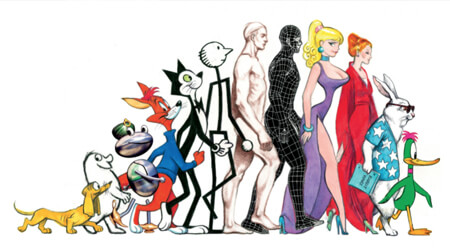The Animator’s Survival Kit – 20th Anniversary Short Guides Reviewed
Around the turn of the millennium the UK witnessed a boom in the amount of animation courses that set up ready to teach the eager minds in the ways of animation. Any decent university course has to have a definitive text to base a curriculum around, so when Richard Williams, the multi-Oscar winning Director of Animation on Who Framed Roger Rabbit decided to dig through the notes and guides he had made for his studio and added to over the years in order to add his own animation opus alongside the likes of Blair, Halas, Johnson & Thomas and a few select others, the mixture of practical advice and frame by frame examination proved a sure fire hit and ended up on the reading lists of any animation course worth registering for.
I find myself in a rather gleeful position to be writing a review of an incarnation of a book that has shaped my understanding of animation as a student and one that I have used extensively in my own teaching.
View this post on Instagram
Williams recognised his own privileged education, having worked with masters of animation from the golden age and in later life having them work for him. When he translated his knowledge into book form it came at just the right time for universities across the land to establish courses and insist that their students buy a copy. As a graduate of this era it became something of a running gag to spot the fellow course mates that handed in direct copies from the pages of The Animators Survival Kit. I’ll admit a ‘sneak’ from the pages of the book may have made it’s way into my own graduation film – If you’re going to copy anyone, you copy the best right? The brand new introductions created for the series show that Williams and those that came before him would agree.
As I moved into teaching myself the fun started again spotting which students ‘misread’ the assignment and decided they could do no better than Williams and opted to hand in a carbon copy of the walk direct from the pages of the book. However, there are many students who use the book properly, understanding that by breaking down animation frame by frame in the book Williams wasn’t just provided a standardised way of animating, he was also providing the detail of what lay between the frames in lavish detail, gifting an adaptable framework for the next generation of animators that could be applied to any medium or method. Not only that but the text of the book gave great insight into his career and credentials as well as heaps of advice from the old masters he knew too. There is one piece of advice I always shared with my students which didn’t come from Williams, but from his mother, an accomplished illustrator who advised against following the path of classmates who spend all day practicing their signature under pressure to find a style and identity. She told her young son to avoid getting caught up on finding a style and to ‘just concentrate on the drawing and the style will just occur.’ Advice like this is evergreen.

The new books have taken the weighty tome and divided it into four separate parts. The first book is ‘Dialogue, Directing, Acting and Animal Acting’, the second is ‘Walks’, the third ‘Runs, Jumps and Skips’ and the final book in the series concentrates on ‘Flexibility and Weight’. Each book comes with a brand never before seen introduction from the legendary animator who passed away in 2019 at the age of 86. Though brief it is delightful to read through the new introductions from Williams who wrote them shortly before his passing. With examples coming from interactions with legendary animators and glowing praise for film directors it is a humbling lesson to us all that even the very best of us never stop learning.
If I were forced to draw criticism it would be that by dividing the books a lot of the introduction which includes some cherished gems from the Director are missed out. However what the book loses in volume it gains in portability and usability, these books have been divided for this very reason and will give students an easy book to grab off of the shelf when they wish to work on any of the four areas. In any case the original book and all of its wisdom can be readily purchased for any completist wishing to lug around a copy.
The new editions of the Animators Survival Kit do exactly what they are designed to do – give the reader direct access to a treasure trove of advice focussed directly on specific subjects. Like their predecessor these new books are perfect for anyone wishing to perfect their animation craft.
Four brand new editions of The Animators Survival Kit are released on 5 August 2021 by Faber. You can also listen to the much missed Director in episode 33 of the Skwigly Animation Podcast below.

